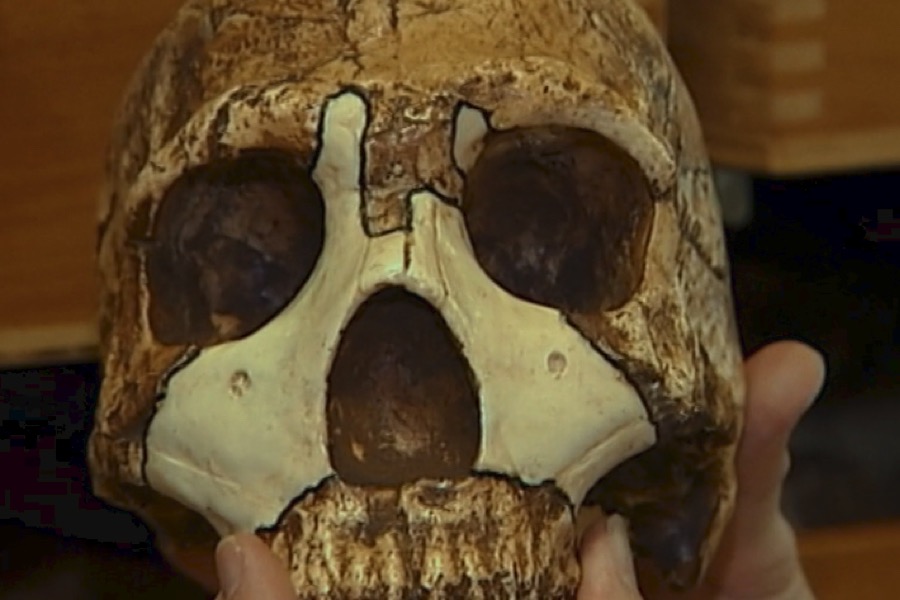“A scattergun history lesson beset with schoolboy humour…” Shezad Dawood’s Leviathan Cycle, Episode 1: Ben — Reviewed

The first episode of Shezad Dawood’s Leviathan Cycle is a scattergun and fictional history lesson beset with schoolboy humour, nursery rhymes, shagging monkeys and Cthulhu-tinged mythology, finds Laura Robertson…
“My height at the time put me at the same level as the giant squid’s eye. Opaque and mirrored – it had an opalescent quality, as if threatening a loss of self as one plunged into its near abyss, language unscrambling as one fell. A black and impenetrable thing, and in that moment it seemed to take me in. LEVIATHAN (…) THAN, THANTHAN.”
Currently playing on loop in The University of Salford’s small art school gallery is a film about a giant squid and the end of the world. Simply projected onto one wall, Shezad Dawood’s Leviathan Cycle, Episode 1: Ben, is a sprawling, 13 minute lunge through a future life on Earth and how we ended up there – a post-apocalyptic world shaped by the Anthropocene era. According to the exhibition rationale, Dawood has consulted with marine biologists, oceanographers, political scientists, neurologists and trauma specialists in order to “explore the notions of marine welfare, migration and mental health and their possible interconnections.” In reality, this first episode is a scattergun and fictional history lesson beset with schoolboy humour, nursery rhymes, shagging monkeys and Cthulhu-tinged mythology.
Ben narrates throughout, starting by reminiscing about his childhood visits to the Natural History Museum with his father, a marine biologist. Young Ben, we hear, found the jars of pickled creatures floating in formaldehyde to be magical and gloriously ghoulish. The camera lingers over dead matter, flesh grey and wet, focusing on suckers and lidless eyes. Two men in lab coats slide one of the cephalopods out onto a metal tray, the kind you might see in a TV-show mortuary. Is this sad specimen the Leviathan? The Devil? This “putrid” thing, Ben explains, was “Like some dark elder God, indifferent and withdrawn from my destiny, as if it had long ago scornfully ceased to play a part in human affairs.”

The film is careful not to reveal any specific reason for the eventual Armageddon, although Ben mentions increased sunspot activity and suicides, and “a level of fatigue [that] seemed to permeate even the survivors.” He mocks humanity for its arrogant stumble towards destruction, driven by a fear of boredom. He equates us to “grand delusional” primates – “A malevolent species of monkey that had evolved hairlessness and sectarian conflict”. We roam woodlands, foraging for food, tearing flesh off bones. This could be a depiction of early man or future man, but the end result is clear: devolution and death. “The world was ending”, the narrator says with dry amusement, “as it had been doing for millennia”.
The last time I saw Dawood’s work was at Eastside Projects in Birmingham in 2008, where he’d presented the Wild West in hand-painted cardboard: a joyous set design for his first full-length film, Feature. The plot involved a tongue-in-cheek re-enactment of The Battle of Little Big Horn, but with zombie cowboys. The DIY aesthetic continues here; Episode 1: Ben edits together YouTube-style clips of plankton and bats and embryos with low budget scenes of survival. There’s a man heating a can of beans over a fire, and then there he is breaking into an ‘abandoned’ apartment. I can’t help but imagine this is the artist’s own flat; the styling process including half-heartedly smearing the toilet with Nutella and scattering clumps of soil and dried leaves on the floor. Dawood’s lyrical and bemused script – which is great and worth reading in full on the accompanying website, leviathan-cycle.com – emphasises this dystopia as pathetic, rather than terrifying.

Overall, Episode 1: Ben doesn’t really make much sense outside of the wider Leviathan Cycle project context. It’s mad. But you wouldn’t critique an entire boxset by just watching the first episode. Commissioned by The University of Salford Art Collection and Leviathan – Human and Marine Ecology Ltd, with support from the Contemporary Art Society, Dawood’s Leviathan Cycle will eventually consist of ten films (or episodes) to be unveiled incrementally over the next three years. A grander presentation of the work made so far was shown in 2017 in Venice, at the former headquarters of the Institute of Marine Sciences. The extra sculptural and textile works there hinted at a Leviathan more deadly: as a tormentor of migrants at sea, as metaphor for trauma. As mentioned, more clues can be found on leviathan-cycle.com, which includes scripts for future episodes narrated by characters Yasmine (II) and Arturo (III), and some superb, urgent research papers, with titles including Italy’s Battle To Identify Dead Migrants.
Whether you are familiar with Dawood’s work or not, Leviathan Cycle should appeal to anyone with a passing interest in the artist’s references: global warming, immigration policy, Lovecraft, Darwin, Shakespeare. What a shame, then, that this archive and wider framework isn’t present in some capacity in the gallery here alongside Episode 1 – on iPads, for instance? – rather than as a link in the press release you can collect by the door. Visitors: go to see the film at The University of Salford, yes, but also go away and look up the rest of the work online. It’s worth it.
Laura Robertson
See Shezad Dawood’s Leviathan Cycle, Episode 1: Ben at the New Adelphi Exhibition Gallery, School of Arts and Media, University of Salford, until Friday 9 March 2018 — FREE
Open Monday-Friday, 10am-4pm, closed Saturdays and Sundays
All images: stills from Shezad Dawood’s Leviathan Cycle, Episode 1: Ben, courtesy the artist





